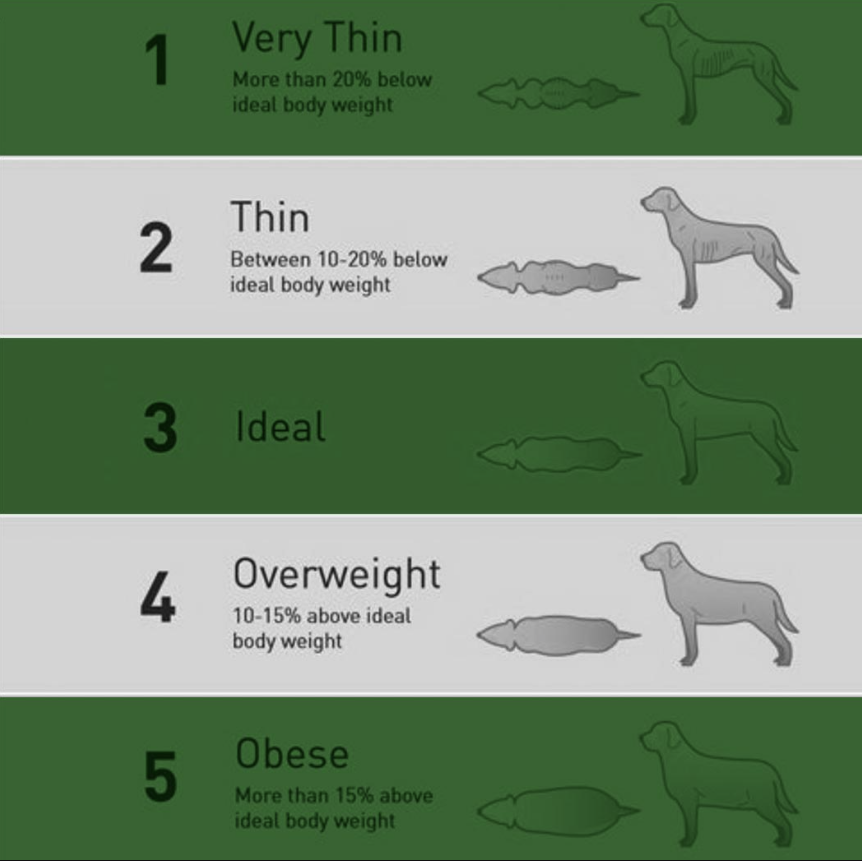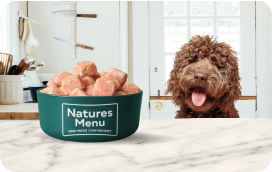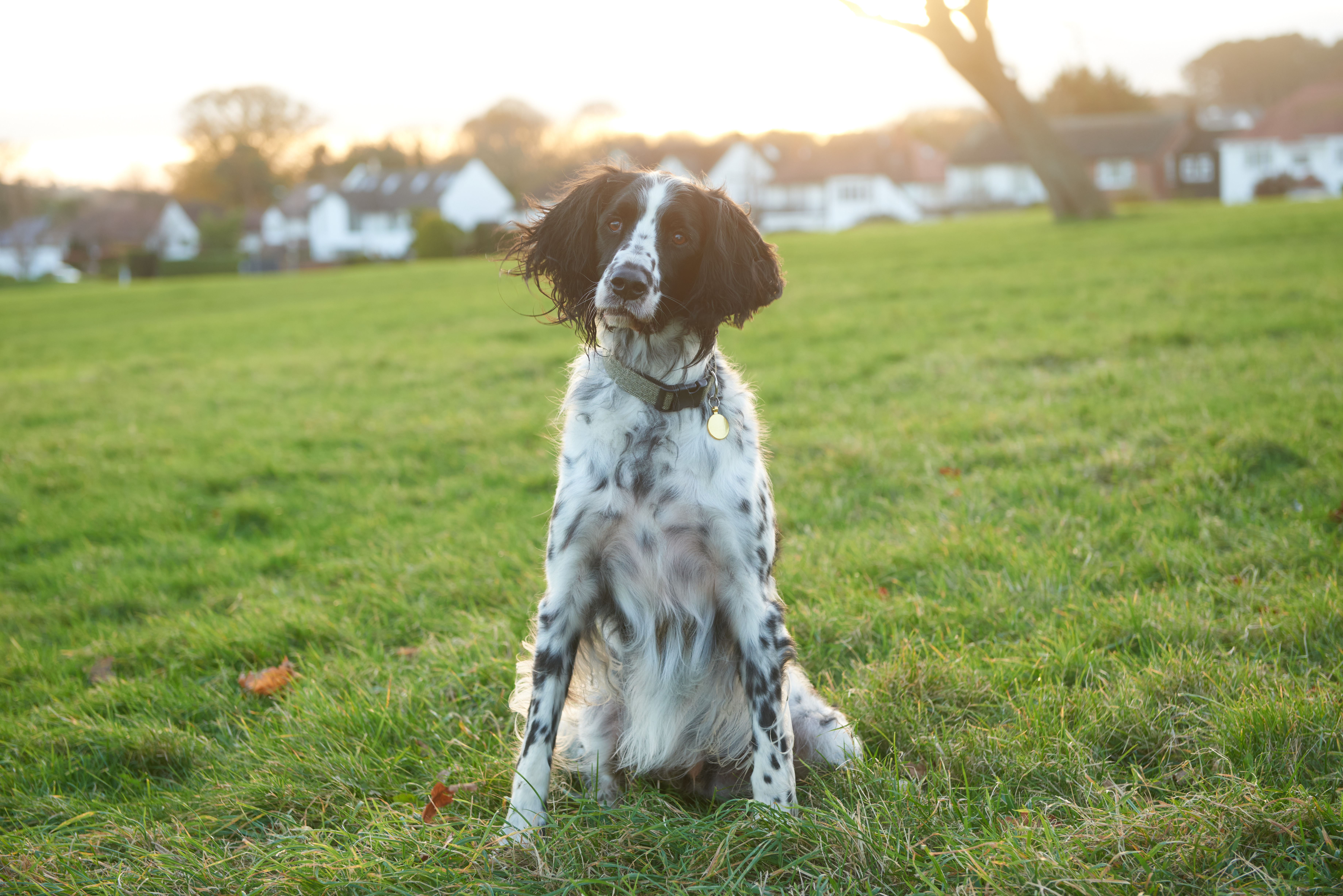Outline:
Quick takeaways on dog weight
- It’s not easy to realise if your dog is overweight, but around half of dogs are too heavy.
- You can check your dog’s body composition score just by feeling and looking at them.
- The difference between working and show breeds’ weight can be big.
Vets agree that obesity in dogs is on the rise, with 1 in 2 dogs in the UK being overweight or obese, according to the 2023 PDSA pet wellbeing survey.
The thing is, it’s not always easy to tell if your pooch is the ideal dog weight. The same survey suggests only 1 in 5 dog owners are aware that their dog is overweight.
It can take a little time to understand if your dog is a healthy size, but it’s worth it. A healthy dog is a happy dog. Plus, it can mean enjoying a longer life together!
For chunkier dogs, getting in shape helps them:
- Avoid painful health problems like arthritis, back pain and breathing problems
- Lower their risk of cancer, injury and heatstroke
- Have a more active and comfortable life
As for underweight dogs, putting on some pounds can help protect them from skin and fur problems, diseases, and muscle loss.
How much should my dog weigh?
The best way to know if your dog is a healthy size is to look at their shape and the scales. Each breed has an ideal weight range, and breeds carry their weight differently.
You’ll need to know:
- The ideal body shape for their breed, measured as a body condition score
- Their ideal body weight for their breed and sex
And if, by the end of this article, you find out you have an underweight dog or one on the bigger side, don’t put yourself in the doghouse.
There’s so much you can do to get your dog back on track, and we’re here to help.
Measuring your dog’s body condition score
Body composition is a visual way to tell if your dog is in shape, and it’s easy to check.
The best part is that most dogs love the special attention and patting. Here’s how to check body composition.
- Run your hands gently over their back and sides. You should be able to feel their spine, ribs and hips, but not see them sticking out.
- Gently feel their tail where it connects to the body. There should be no fat.
- Feel their tummy. See if it goes inwards, bulges out or is neutral.
- Look at your dog from the side, and from above. Their waist should go inwards.
Compare what you find to the chart below.

The ideal weight is in the middle, with underweight and overweight animals scoring lower or higher.
A healthy dog has a slight hourglass shape – when you look at them from above. From the side, your dog’s torso should angle upwards towards their hind legs.
Body composition for different breeds
Dog breeds have slight differences in their ideal body composition. Next time you visit the vet, ask them if there’s anything special you should know about your dog’s breed.
Certain breeds are naturally more trim, so it’s normal to see their ribs (but not their hips or spine). This includes whippets, greyhounds and some sighthounds like Salukis and Borzoi.
Other breeds carry more muscle. Corgis can look a little chunky when they’re just right. In general, you should still see some waist definition.
Coat length is another challenge. The best time to pat your fluffy dog down would be after a haircut or when they’re wet, but it can still be tricky.
A longer coat can also hide an underweight dog, so be sure to make haircuts a regular thing and keep checking your dog’s body composition score.
Dog breed weight chart
When it comes to stepping on the scales, knowing the average healthy weight range is a good place to start.
Your dog might be above or below these ranges and still be healthy (we’ll cover why in the next section), but the range provides an easy benchmark.
Here’s a list of ideal weights for some of the most common dog breeds.
| Dog Breed |
Female Weight |
Male Weight |
| Afghan Hound |
22.7-27.2 kg |
22.7-27.2 kg |
| Airedale Terrier |
18.2-23.1 kg |
20-31.8 kg |
| Alaskan Malamute |
32.2-38.1 kg |
35.6-43.1 kg |
| Australian Shepherd |
18.1-25 kg |
22.7-29.5 kg |
| Basenji |
9.1-10.9 kg |
10-11.8 kg |
| Basset Hound |
18.1-29.5 kg |
25-34 kg |
| Beagle |
9.1-10 kg |
9.1-10 kg |
| Bearded Collie |
7.7-25 kg |
22.7-27.2 kg |
| Bedlington Terrier |
7.7-10.4 kg |
7.7-10.4 kg |
| Belgian Malinois |
18.1-27.2 kg |
27.2-36.3 kg |
| Belgian Sheepdog |
20.4-27.2 kg |
25-34 kg |
| Bernese Mountain Dog |
31.8-43.1 kg |
36.3-52.1 kg |
| Bichons Frise |
5.4-8.2 kg |
5.4-8.2 kg |
| Bloodhound |
36.3-45.4 kg |
40.8-49.9 kg |
| Border Collie |
13.6-19.1 kg |
13.6-20.4 kg |
| Border Terrier |
5.2-6.4 kg |
5.9-7 kg |
| Boxer |
25-29.5 kg |
29.5-36.3 kg |
| Brussels Griffons |
3.6-4.5 kg |
3.6-4.5 kg |
| Bull Terrier |
20.4-25 kg |
25-29.5 kg |
| Bulldog |
18.1-20 kg |
22.7-25 kg |
| Bullmastiff |
45.4-54.4 kg |
49.9-59 kg |
| Cairn Terrier |
5.9-7.3 kg |
6.4-7.4 kg |
| Cane Corso |
38.6-45.4 kg |
40.8-49.9 kg |
| Cavalier King Charles Spaniel |
5.9-8.2 kg |
5.9-8.2 kg |
| Chihuahua |
2.3-3.2 kg |
2.7-3.6 kg |
| Chinese Crested |
2.3-5.4 kg |
2.3-5.4 kg |
| Chow Chow |
20.4-31.8 kg |
20.4-31.8 kg |
| Collie |
22.7-29.5 kg |
27.2-34 kg |
| Dachshund Miniature |
less than 5 kg |
less than 5 kg |
| Dachshund Standard |
7.3-14.5 kg |
7.3-14.5 kg |
| Dalmation |
20.4-27.2 kg |
20.4-27.2 kg |
| Doberman Pinscher |
27.2-40.8 kg |
34-45.4 kg |
| Dogues de Bordeaux |
54.4-63.5 kg |
54.4-63.5 kg |
| English Foxhound |
22.7-31.8 kg |
27.2-34kg |
| English Toy Spaniel |
3.6-6.4 kg |
3.6-6.4 kg |
| Fox Terrier Smooth/Wire |
6.8-7.7 kg |
7.2-8.2 kg |
| French Bulldog |
7.3-10.9 kg |
9.1-12.7 kg |
| German Pinscher |
11.3-20.4 kg |
11.3-20.4 kg |
| German Shepherd |
22.6-31.8 kg |
29.5-40.8 kg |
| Giant Schnauzer |
25-34 kg |
27.2-38.6 kg |
| Great Dane |
49.9-63.5 kg |
63.5-79.4 kg |
| Great Pyrenees |
38.6-45.4 kg |
45.4-49.9 kg |
| Greyhound |
27.2-29.5 kg |
29.5-31.8 kg |
| Ibizan Hound |
18.1-22.7 kg |
20.4-25 kg |
| Irish Terrier |
11.3-12.2 kg |
11.3-12.2 kg |
| Irish Wolfhound |
47.6-61.2 kg |
54.4-74.8 kg |
| Italian Greyhound |
3.2-6.4 kg |
3.2-6.4 kg |
| Japanese Chin |
3.2-5 kg |
3.2-5 kg |
| Maltese |
2.7-4.1 kg |
2.7-4.1 kg |
| Manchester Terrier |
5.4-10 kg |
5.4-10 kg |
| Mastiff |
54.4-77.1 kg |
72.6-104.3 kg |
| Newfoundland |
45.4-54.4 kg |
59-68 kg |
| Old English Sheepdog |
27.2-36.3 kg |
31.8-40.8 kg |
| Otterhound |
29.5-52.2 kg |
29.5-52.2 kg |
| Papillion |
4.1-4.5 kg |
4.1-4.5 kg |
| Pekingese |
3.2-6.4 kg |
3.2-6.4 kg |
| Pembroke Welsh Corgis |
10-11.8 kg |
11.8-13.6 kg |
| Pembroke Welsh Corgis |
10-11.8 kg |
11.8-13.6 kg |
| Pharaoh Hound |
20.4-22.7 kg |
22.7-25 kg |
| Pointer |
20.4-29.5 kg |
25-34 kg |
| Pomeranian |
1.4-3.2 kg |
1.4-3.2 kg |
| Poodle Miniature |
4.5-6.8 kg |
4.5-6.8 kg |
| Poodle Standard |
18.1-22.7 kg |
27.2-31.8 kg |
| Portuguese Podengo |
15.9-30 kg |
15.9-30 kg |
| Portuguese Water Dog |
15.9-22.7 kg |
19.1-27.2 kg |
| Pug |
6.4-8.2 kg |
6.4-8.2 kg |
| Retriever Flat/Curly-Coated |
27.2-31.8 kg |
27.2-31.8 kg |
| Retriever Labrador |
25-31.8 kg |
29.5-36.3 kg |
| Retreiver Golden |
25-29.5 kg |
29.5-36.3 kg |
| Retriever Nova Scotia Duck Tolling |
15.9-22.7 kg |
15.9-22.7 kg |
| Rhodesian Ridgeback |
29.5-36.3 kg |
36.3-40.8 kg |
| Rottweiler |
36.3-45.4 kg |
43.1-61.2 kg |
| Russell Terrier |
4.1-6.8 kg |
4.1-6.8 kg |
| Saluki |
15.9 -29.5 kg |
15.9 -29.5 kg |
| Samoyed |
15.9-22.7 kg |
20.4-29.5 kg |
| Scottish Terrier |
8.2-9.5 kg |
8.6-4.3 kg |
| Setter English |
20.4-25 kg |
29.5-36.3 kg |
| Setter Irish Red and White |
27.2-31.8 kg |
27.2-31.8 kg |
| Shetland Sheepdog |
6.8-11.3 kg |
6.8-11.3 kg |
| Shih Tzu |
4.1-7.3 kg |
4.1-7.3 kg |
| Siberian Husky |
15.9-22.7 kg |
20.4-27.2 kg |
| Sloughi |
13.6-22.7 kg |
13.6-22.7 kg |
| Soft Coated Wheaten Terrier |
13.6-15.9 kg |
15.9-18.1 kg |
| Spaniel American Water |
11.3-18.1 kg |
13.6-20.4 kg |
| Spaniel English Cocker |
11.8-14.5 kg |
12.7-15.4 kg |
| Spaniels Welsh Springer |
15.9-22.7 kg |
18.1-25 kg |
| Spanish Water Dogs |
14.1-18.1 kg |
18.1-22.2 kg |
| Spinone Italiano |
28-39 kg |
28-39 kg |
| Saint Bernard |
54.4-63.5 kg |
63.5-81.7 kg |
| Staffordshire Bull Terrier |
10.9-15.4 kg |
12.7-17.2 kg |
| Standard Schnauzer |
13.6-20.4 kg |
15.9-22.7 kg |
| Swedish Vallhund |
9.1-15.8 kg |
9.1-15.8 kg |
| Tibetan Mastiff |
31.8-54.4 kg |
40.8-68 kg |
| Tibetan Terrier |
8.2-13.6 kg |
8.2-13.6 kg |
| Vizsla |
20-25 kg |
25-27 kg |
| Weimaraner |
25-34 kg |
31.8-40.8 kg |
| Welsh Terrier |
8.6-10 kg |
8.6-10 kg |
| West Highland White Terrier |
6.8-9.1 kg |
6.8-9.1 kg |
| Whippet |
9.1-15.9 kg |
11.3-18.1 kg |
| Yorkshire Terrier |
1.8-3.2 kg |
1.8-3.2 kg |
Table adapted from the Association for Pet Obesity Prevention
Factors affecting body weight
Just like us, every dog is different weight-wise. They might fall outside the ideal range for their breed but still be healthy, depending on their overall size and muscle mass.
Your dog’s genetics can mean they’re bigger, smaller or more muscly than a typical example of their breed. Their parents can give you a good clue as to what’s normal for them.
How to measure your dog’s weight
Scales can help you stay on top of your dog’s weight. It’s particularly helpful for breeds that are tricky to judge body composition, like super fluffy breeds.
Large floor scales are the safest way to weigh your dog. It’s the perfect excuse to visit the pet store, as large ones usually have pet-friendly scales. Your vet will also have some, generally in their reception room.
Sometimes, dogs are scared to step on the scales, especially if they aren’t used to it or get nervous from the scent of other dogs.
You can try leading them onto the scale with a treat or getting on the scales with your dog (just remember to subtract your weight from the number afterwards.)
Is dog BMI a thing and how is it measured?
BMI stands for body mass index. It’s usually used for people, but there are also BMI calculators for dogs.
If you struggle with guessing your dog’s body composition, then a BMI calculator can be a helpful alternative. It’s different from weight because it accounts for their height too.
Use a BMI calculator specific to your dog’s breed, or else it won’t be accurate.
Why do dogs gain or lose weight?
Just like you, your dog’s weight can fluctuate naturally over the seasons and across their lifespan.
For your peace of mind, it’s good to know what to be aware of (and when to take action).
A dog can lose weight because:
- They’re getting older
- They’ve been more active
- It’s winter - they’re using more energy to keep warm
- They’re not getting enough calories from their food.
A dog can gain weight because:
- They’re exercising less, maybe due to injury or hot weather
- They’re getting too many calories from their food (and/or treats).
If your dog is gaining or losing weight and it isn’t explained by the above, it could be an underlying illness – so take them to the vet as soon as possible.
Don’t beat yourself up if they aren’t at the ideal dog weight of their diet or exercise. Now you’ve spotted it and you can help them get back in shape!
Key signs your dog might be overweight or underweight
Your dog may be overweight if:
- You can’t feel their ribs, hips or spine
- They have no visible waistline
- They have body fat around their neck, shoulders, hips and tail
Your dog could be underweight if:
- You can see their ribs, hips or spine poking out
- They have no body fat
- They’re below their breed’s healthy weight range
Read more about the key signs your dog is underweight or overweight.
Tips for maintaining a healthy weight
Luckily, there’s lots you can do to help your dog maintain a healthy shape or get them back on track.
From making sure they’re getting a balanced diet to adjusting their exercise – all these small things can add up to a big difference.
When it comes to putting the plan into action, our top tips are:
- Be consistent – a routine helps you and your dog keep healthy habits
- Get the whole family involved – check everyone caring for your dog knows the plan and sticks to it
- Check out our expert guides for more tips on gaining weight and losing weight for dogs.
Ideal dog weight FAQs
How does weight change as a dog gets older?
Some dogs may lose weight as they age. This can be caused by:
- Lower appetite
- Slower and less efficient digestion
- Loss of muscle mass
This isn’t usually anything to worry about unless they’re losing weight quickly. In this case, it’s best to get your dog to a vet.
Dogs can also gain weight as they age, especially if they become less active due to painful conditions like arthritis.
What if my dog is a working dog?
The differences between the ideal dog weight according to working and show standards can also be pretty striking. For example, working Labradors tend to have a slighter, leaner and more athletic build than show Labradors, who can be stockier.
To keep a working dog’s weight healthy, you’ll want to aim for plenty of healthy protein, and a raw diet is perfect for this. This helps to maintain the extra muscle and energy.
How can I help my dog lose weight?
If your dog is overweight, you can help them get to a healthy size with a few simple changes.
- Aim for 1-3 hours of activity and playtime a day
- Try a high protein low carb diet to keep them fuller for longer
- Cut down the treats and switch to healthier alternatives like raw treats.
Check our full guide for a step-by-step plan to help your dog lose weight safely.
How can I help my dog gain weight?
There are plenty of easy steps you can take to help them put on some healthy pounds.
- Add healthy carbs to their meals like cooked brown rice, cooked sweet potato or a handful of our Mighty Mixer Biscuits
- Look at more calorie-dense foods
- Increase their portion sizes slightly
- Try feeding them more healthy snacks
Even though you want to help your dog pad out, it’s best not to start unhealthy habits. And, if you’re upping their calories, make sure it’s from healthy sources, like a raw diet or raw treats.
Check our full guide for a step-by-step plan to help your dog gain weight the right way.
Try our personalised meal plans with high-quality raw ingredients to help keep your dog healthy and happy.









